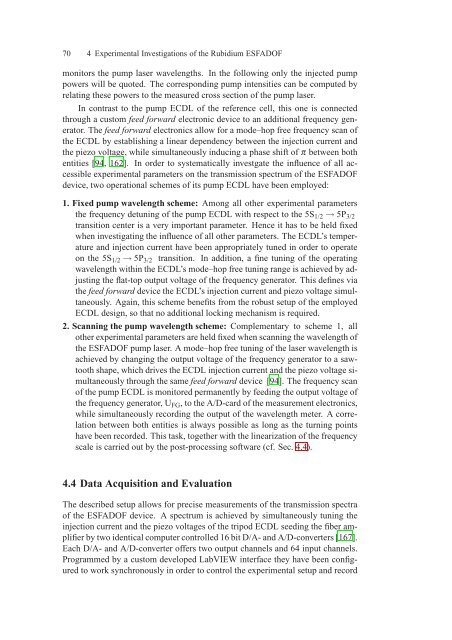Assessment of a Rubidium ESFADOF Edge-Filter as ... - tuprints
Assessment of a Rubidium ESFADOF Edge-Filter as ... - tuprints
Assessment of a Rubidium ESFADOF Edge-Filter as ... - tuprints
You also want an ePaper? Increase the reach of your titles
YUMPU automatically turns print PDFs into web optimized ePapers that Google loves.
70 4 Experimental Investigations <strong>of</strong> the <strong>Rubidium</strong> <strong>ESFADOF</strong><br />
monitors the pump l<strong>as</strong>er wavelengths. In the following only the injected pump<br />
powers will be quoted. The corresponding pump intensities can be computed by<br />
relating these powers to the me<strong>as</strong>ured cross section <strong>of</strong> the pump l<strong>as</strong>er.<br />
In contr<strong>as</strong>t to the pump ECDL <strong>of</strong> the reference cell, this one is connected<br />
through a custom feed forward electronic device to an additional frequency generator.<br />
The feed forward electronics allow for a mode–hop free frequency scan <strong>of</strong><br />
the ECDL by establishing a linear dependency between the injection current and<br />
the piezo voltage, while simultaneously inducing a ph<strong>as</strong>e shift <strong>of</strong> π between both<br />
entities [94, 162]. In order to systematically investgate the influence <strong>of</strong> all accessible<br />
experimental parameters on the transmission spectrum <strong>of</strong> the <strong>ESFADOF</strong><br />
device, two operational schemes <strong>of</strong> its pump ECDL have been employed:<br />
1. Fixed pump wavelength scheme: Among all other experimental parameters<br />
the frequency detuning <strong>of</strong> the pump ECDL with respect to the 5S 1/2 → 5P 3/2<br />
transition center is a very important parameter. Hence it h<strong>as</strong> to be held fixed<br />
when investigating the influence <strong>of</strong> all other parameters. The ECDL’s temperature<br />
and injection current have been appropriately tuned in order to operate<br />
on the 5S 1/2 → 5P 3/2 transition. In addition, a fine tuning <strong>of</strong> the operating<br />
wavelength within the ECDL’s mode–hop free tuning range is achieved by adjusting<br />
the flat-top output voltage <strong>of</strong> the frequency generator. This defines via<br />
the feed forward device the ECDL’s injection current and piezo voltage simultaneously.<br />
Again, this scheme benefits from the robust setup <strong>of</strong> the employed<br />
ECDL design, so that no additional locking mechanism is required.<br />
2. Scanning the pump wavelength scheme: Complementary to scheme 1, all<br />
other experimental parameters are held fixed when scanning the wavelength <strong>of</strong><br />
the <strong>ESFADOF</strong> pump l<strong>as</strong>er. A mode–hop free tuning <strong>of</strong> the l<strong>as</strong>er wavelength is<br />
achieved by changing the output voltage <strong>of</strong> the frequency generator to a sawtooth<br />
shape, which drives the ECDL injection current and the piezo voltage simultaneously<br />
through the same feed forward device [94]. The frequency scan<br />
<strong>of</strong> the pump ECDL is monitored permanently by feeding the output voltage <strong>of</strong><br />
the frequency generator, U FG , to the A/D-card <strong>of</strong> the me<strong>as</strong>urement electronics,<br />
while simultaneously recording the output <strong>of</strong> the wavelength meter. A correlation<br />
between both entities is always possible <strong>as</strong> long <strong>as</strong> the turning points<br />
have been recorded. This t<strong>as</strong>k, together with the linearization <strong>of</strong> the frequency<br />
scale is carried out by the post-processing s<strong>of</strong>tware (cf. Sec. 4.4).<br />
4.4 Data Acquisition and Evaluation<br />
The described setup allows for precise me<strong>as</strong>urements <strong>of</strong> the transmission spectra<br />
<strong>of</strong> the <strong>ESFADOF</strong> device. A spectrum is achieved by simultaneously tuning the<br />
injection current and the piezo voltages <strong>of</strong> the tripod ECDL seeding the fiber amplifier<br />
by two identical computer controlled 16 bit D/A- and A/D-converters [167].<br />
Each D/A- and A/D-converter <strong>of</strong>fers two output channels and 64 input channels.<br />
Programmed by a custom developed LabVIEW interface they have been configured<br />
to work synchronously in order to control the experimental setup and record
















